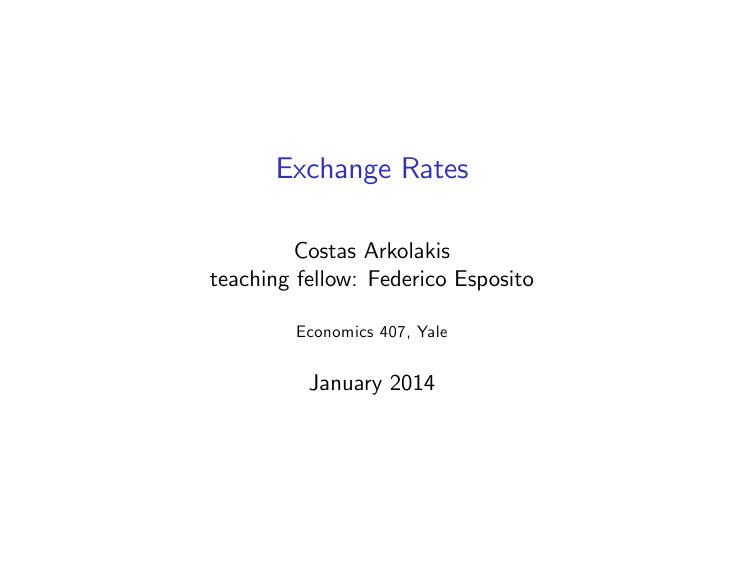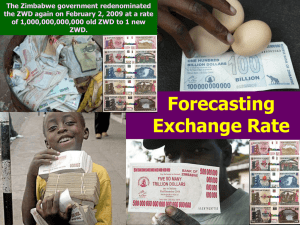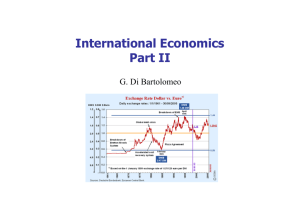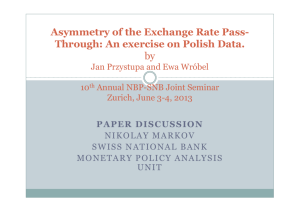Week 3: Exchange Rates
advertisement

Exchange Rates
Costas Arkolakis
teaching fellow: Federico Esposito
Economics 407, Yale
January 2014
Outline
De…nitions: Nominal and Real Exchange Rate
A Theory of Determination of the Real Exchange Rate
Foreign Exchange Market
Price Arbitrage: Purchasing Power Parity
Interest Rate Arbitrage: Uncovered and Covered Interest Rate Parity
Determination of the Nominal Exchange Rate
De…nitions: Nominal Exchange Rate (NER)
Nominal Exchange Rate is the price of a foreign currency in terms of
the home currency
E$/e = 1.3467=US exchange rate (in US terms, Dollars per Euro)
Ee/ $ = 0.7425=Euro exchange rate (in European terms, Euros per Dollar)
Thus, E$/e = 1/Ee/$
An increase in E$/e means a dollar depreciation.
If a currency can buy more (less) of another currency, we say it has been
appreciated (depreciated)
" E$/e or Ee/ $ # : dollar depreciation, euro appreciation
Nominal vs Real Exchange Rates (RER)
Real exchange rate is the Nominal Exchange rate times the inverse of
the relative price levels
Dollar pound real exchange rate
e$/£ = E$/£
PUK
PUS
where E$/£ :dollar price of 1 pound, PUK : is the price level in UK, P US
price level in US
e$/£ : the relative price of a consumption basket in the UK in terms of
consumption in US
US dollar depreciation vs other Currencies
Makes US residents relatively poorer
Makes US products cheaper to foreigners
Figure: Source: Feenstra and Taylor 2010
US dollar depreciation vs other Currencies
Makes US residents relatively poorer
Makes US products cheaper to foreigners
US dollar Depreciation and Appreciation
Currency Crisis: Argentinian Peso depreciation
Between Jan and Jul ’02, Argentine Peso depreciated 70%
What does it mean for Argentinians?
Headline News: E¤ects on Argentinians
Consequences of the Argentinian devaluation episode
Jan 2002, Argentine gov. announced default on $155 billion in debt.
Unrest, political upheaval
As of 2006, unemployment rate was still 10%.
In‡ation increased dramatically for 2 years, still remains high.
Real GDP in dollars fell dramatically.
Figure: Argentine and World Real GDP per capita in $ (World Bank)
Real Exchange Rate Determination
Real Exchange Rates
Real exchange rates are persistent
Figure: Consumer Price Indices (CPI) for UK and US in US dollar terms (log scale).
Taylor and Taylor, Journal of Economic Perspectives, 2004.
A Theory of Determination of the Real Exchange Rate
Objective: A Theory of What Determines RER
A Theory of RER is far easier to develop:
In general, economic theories work better with real than nominal
magnitudes
Step 1: Derive a relationship between RER and relative prices
Step 2: Derive a relationship between relative prices and economic
fundamentals
Step 1: RER and Relative Prices
De…nitions:.
PT : price of tradeables,
PN : price of non-tradeables,
P : overall price level
‘*’indicates foreign variable.
Assumptions:
“Law of one price” holds for traded goods PT = EPT
For nontraded goods, in general, PN 6= EPN
Step 1: RER and Relative Prices
Assume the price level, P, is a function φ (., .) of the price of tradables
and nontradables, P = φ (PT , PN ), where φ is homogeneous of degree 1
Homogeneous of degree 1: φ (x, y ) = λφ (x /λ, y /λ), or
λφ (x, y ) = φ (λx, λy )
The Impact of Non-Tradables in the RER
Assume P = φ (PT , PN ) where φ is homogeneous of degree 1
e
=
EP
P
E φ (PT , PN )
φ (PT , PN )
P
=
EPT φ 1, P N
T
PT φ 1,
PN
PT
Now use Law of one price for tradeables, PT = EPT ,
e = φ 1,
PN
PT
φ 1,
PN
PT
The Impact of Non-Tradeables in the RER
P
Law of one price implies e = φ 1, P N
T
P
.
φ 1, PPTN
PN
Therefore, e > 1 if P N > P
., i.e. RER depends on relative prices of
T
T
tradeables to non-tradeables
Is this true in the data?
We will study the academic research on this hypothesis in detail later on
The last piece of the theory is to develop a theory of how
determined
PN
PT
is
The Impact of Non-Tradeables in the RER
P
Law of one price implies e = φ 1, P N
T
P
.
φ 1, PPTN
PN
Therefore, e > 1 if P N > P
., i.e. RER depends on relative prices of
T
T
tradeables to non-tradeables
Is this true in the data?
We will study the academic research on this hypothesis in detail later on
The last piece of the theory is to develop a theory of how
determined
The Balassa-Samuelson e¤ect
PN
PT
is
Step 2: Relative Prices & Economic Fundamentals
(Balassa-Samuelson)
A theory with Nontradeables and Tradeables
2 goods, traded: QT , non-traded: QN
Production functions: QT = aT LT , QN = aN LN
ai :productivity, Li : labor used, where i = T , N
Pro…ts in each sector Pi Qi
wLi , where i = N, T
Zero pro…t condition: Pi Qi = wLi , for i = N, T
Using production functions Pi ai Li = wLi =) w = Pi ai
Therefore,
PN
a
= T
PT
aN
The Balassa-Samuelson E¤ect in the Data
Foreign Exchange Market
The Market for Foreign Exchange
Exchange rates are set minute by minute in the Foreign Exchange
(Forex) market
Individuals, corporations, public institutions trade currencies
An over-the-counter market since it is not an organized exchange market
The global currency trade is 3.2 trillion per day, 290% more than in 1992
Major exchange centers: UK, US, Japan
Largest Currency Traders
Spot Contracts
Spot exchange: a contract for immediate exchange of currencies
In the rest of the course, we will mostly talk about spot contracts
How it works
Trader 1 calls Trader 2 and asks for a price of a currency, say GBP
The bid price is the exchange rate (ER) at which 2 is willing to buy GBP
The ask (or o¤er) price is the ER at which 2 is willing to sell GBP
The di¤erence (bid-ask spread) generates pro…ts for Trader 2
Derivatives
Derivatives: contracts for which their pricing is derived from the spot
rate
Forwards, swaps, futures and options.
These contrants exist to allow investors to trade currency for delivery at
di¤erent times or with di¤erent contigencies
Forwards: It is a contract where the settlement date for the delivery of
the currencies is forward in the future for a set price
E.g. the time of the delivery -the maturity- could be 90 days from now, a
year from now etc
Because the contract has a …xed price it carries no risk.
Price Arbitrage: Purchasing Power Parity
Absolute & Relative Purchasing Power Parity (PPP)
Absolute PPP: Real exchange rate is expected to be 1
Absolute Purchasing Power Parity would imply:
log (E$/£ PUK ) log (PUS )
PPP refers to the price index while law of one price to one good at a time
Relative PPP implies that there no expected movements in the
Real exchange rate
Relative Purchasing Power Parity would imply:
d log (E$/£ PUK ) d log (PUS )
Absolute Purchasing Power Parity
Absolute PPP: Real exchange rate is expected to be 1
Absolute Purchasing Power Parity would imply:
log (E$/£ PUK ) log (PUS )
PPP is based on the law of one price: in the absense of transaction
costs, prices should be the same across markets because of arbitrage
In the short run, obviously this is not true.
Absolute PPP in the Data
If all the goods were instantly tradeable, PPP theory should be
true!
Not true in the short run. Approximately true in the long-run.
Figure: Consumer Price Indices (CPI) for UK and US in US dollar terms (log scale).
Taylor and Taylor, Journal of Economic Perspectives, 2004.
Testing for Relative PPP
t Pt
Postulate that log E$/£
UK
t
log (PUS
) for some time t.
We know that for small periods, it may not hold. Can it hold over large
periods of time?
Consider the following derivation
t
t
log E$/
£ PUK
t n t n
log E$/
£ PUK
t
log PUS
t n
t
t n
t
/PUK
+ log PUK
log E$/
£ /E$/£
t n
t
log (E$/
£ /E$/£ )
|
{z
}
change in
exchange rate
t
log (PUS
/P t n )
| {z US }
Ratio of prices
in the US (in‡ation)
t n
log PUS
t n
t
/PUS
log PUS
=)
=)
t
/P t n )
log (PUK
|
{z UK }
Ratio of prices
in the UK (in‡ation)
We can now proceed and look at the empirical counterparts
Relative PPP in the long-run
Taylor and Taylor ’04 paper. Testing PPP in the long-run
Failure to generate PPP
Obviously not all goods are tradeable.
Example of non-tradeable goods: haircuts, restaurant meals
For many countries, non-tradeable goods are more than 1/2 of GDP.
Interest Rate Arbitrage: Covered & Uncovered Interest
Parity
Interest Rate Parity
Interest Rate Parity: Given foreign exchange market equilibrium, the
interest rate parity condition implies that the expected return on
domestic assets will equal the exchange rate-adjusted expected return on
foreign currency assets.
Two types of interest rate parity
Covered Interest Rate Parity and Uncovered Interest Rate parity
Covered Interest Parity
Covered interest rate parity: no arbitrage condition that states that
the interest rate di¤erential is covered with the use of a forward contract:
1 + it =
(1 + r )
| {z }
Ft
Et
foreign bonds return
Ft : Forward exchange rate at time t
This interest rate di¤erential is called covered because the use of the
forward exchange rate covers the investor against exchange rate risk.
It is expected to hold approximately when capital markets are perfect.
Covered Interest Parity in the Data
Figure: Domestic Interbank minus Eurocurrency 3-month interest rates
More Evidence on Covered Interest Parity
Figure: Deviations from Covered Interest Parity over time (Source: Courtesy of
Lorenzo Caliendo)
Uncovered Interest Parity
Uncovered interest rate parity: a no-arbitrage condition that states
that the interest rate di¤erential equals to the expected change of the
interest rate (e.g. due to expected in‡ation in one country)
1 + it =
(1 + r )
| {z }
Ete+1
Et
foreign bonds return
Ete+1 :
expected nominal exchange rate at time t + 1.
In the absense of uncertainty we have Ete+1 = Et +1 :
1 + it
| {z }
gross return of domestic bond
=
E t +1
(1 + r )
E
|
{z t }
return of foreign bonds in domestic currency
Limited evidence to support the validity of this assumption: hard to
measure Ete+1
Uncovered Interest Parity
Uncovered interest rate parity: a no-arbitrage condition that states
that the interest rate di¤erential equals to the expected change of the
interest rate (e.g. due to expected in‡ation in one country)
1 + it =
(1 + r )
| {z }
Ete+1
Et
foreign bonds return
Ete+1 :
expected nominal exchange rate at time t + 1.
In the absense of uncertainty we have Ete+1 = Et +1 :
1 + it
| {z }
gross return of domestic bond
=
E t +1
(1 + r )
E
|
{z t }
return of foreign bonds in domestic currency
Limited evidence to support the validity of this assumption: hard to
measure Ete+1
Still a great theoretical device for rational expectation models!
Uncovered Interest Parity
Uncovered interest rate parity: a no-arbitrage condition that states
that the interest rate di¤erential equals to the expected change of the
interest rate (e.g. due to expected in‡ation in one country)
1 + it =
(1 + r )
| {z }
Ete+1
Et
foreign bonds return
Ete+1 :
expected nominal exchange rate at time t + 1.
In the absense of uncertainty we have Ete+1 = Et +1 :
1 + it
| {z }
gross return of domestic bond
=
E t +1
(1 + r )
E
|
{z t }
return of foreign bonds in domestic currency
Limited evidence to support the validity of this assumption: hard to
measure Ete+1
Still a great theoretical device for rational expectation models!
Of course if capital markets are perfect and expectations are correct
Ft = Ete+1
Nominal Exchange Rate Determination
The Money Demand
Assume a money demand of the form
Mt
= L (C̄ , it )
Pt
Mt denotes money
Pt denotes price level
C̄ denotes consumption
it denotes nominal interest rate
L (., .) is liquidity preference increasing in C̄ , decreasing in i
Money Demand
No barriers to international trade
PPP implies that Pt = Et Pt . Normalize one price (Warlas law) Pt = 1.
Combining PPP with money demand, we have
Mt
Mt
=
= L (C̄ , it )
Pt
Et
Government Budget Constraint
Govenrment has three sources of income
tax revenues, Pt Tt , money creation, Mt
bonds Et r Btg 1
Spending on new bonds Et Btg
Btg
1
Mt
1,
, government expenditure,
Pt Gt Et Btg Btg 1 + Pt Gt = Pt Tt + (Mt
|
{z
}
change in bond holdings
interest from foreign
Mt
1 ) + Et r
Btg
1
Government Budget Constraint
Govenrment has three sources of income
tax revenues, Pt Tt , money creation, Mt
bonds Et r Btg 1
Spending on new bonds Et Btg
Btg
1
Mt
1,
interest from foreign
, government expenditure,
Pt Gt Et Btg Btg 1 + Pt Gt = Pt Tt + (Mt
|
{z
}
Mt
1 ) + Et r
change in bond holdings
Dividing by Pt = Et ,
Btg
Btg
1
=
Mt
|
Mt 1
Pt
{z
}
seignorage revenue
Gt
|
Tt
{z
r Btg
1
real secondary de…cit
}
Btg
1
Government Budget Constraint
Govenrment has three sources of income
tax revenues, Pt Tt , money creation, Mt
bonds Et r Btg 1
Spending on new bonds Et Btg
Btg
1
Mt
1,
interest from foreign
, government expenditure,
Pt Gt Et Btg Btg 1 + Pt Gt = Pt Tt + (Mt
|
{z
}
Mt
1 ) + Et r
Btg
1
change in bond holdings
Dividing by Pt = Et ,
Btg
Btg
1
=
Mt
|
Mt 1
Pt
{z
}
seignorage revenue
Gt
|
Tt
{z
r Btg
1
real secondary de…cit
}
Fiscal de…cit must be accompanied by money creation or decline in assets.
Fixed Exchange Rate Regime
Fixed exchange regime: the government intervenes in the foreign
exchange market in order to keep the exchange rate at a …xed level
Government intervenes so that Et = E
Given E , PPP implies that Pt = E .
Also, PPP and uncovered interest rate parity imply it = r .
Money demand is thus …xed, EL (C̄ , r ) = Mt /Pt = Mt /E
Equilibrium in the money market, implies Mt = EL (C̄ , r ) = Mt
money demand is …xed
E¤ectively, seignorage revenue is lost
Btg
Btg
1
=
Gt
|
Tt
{z
r Btg
1
real secondary de…cit
}
1,
i.e.
Floating Exchange Rate Regime
Floating Exchange Rate: the government lets the nominal exchange
rate be determined in the foreign exchange market.
In this case, the model implies (under conditions) that
Et + 1
Pt +1
=
Et
Pt
As we have seen there is a strong connection between the exchange rate
and the growth of prices



